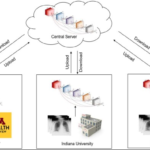ヒト乳頭腫ウイルスが原因の場合もあるが、最も致死率の高い頭頸部がんは染色体異常と関連していることが、新しい研究で明らかになった。 Human papilloma virus causes some cases, but the most lethal form of head and neck cancer is linked to chromosomal alterations; a new study sharpens that association and hints of more effective treatment options
2022-11-17 カリフォルニア大学サンディエゴ校(UCSD)
昨年発表された研究では、同じ研究チームが、HPV陰性頭頸部がんの免疫逃避とICT耐性を引き起こす9番染色体短腕の遺伝子領域のコピー消失の影響を初めて発見し、その基礎を築いた。
今回の研究は、4つの異なる患者コホートにおいて、各遺伝子座の各バンドと各バンド内の各遺伝子を解析し、マルチアミクス免疫遺伝学的証拠に基づいて答えを導き出したものである。
研究者らは、9p-gain 症例、すなわち 9p24.1 band の発現が 60 パーセンタイル以上の腫瘍を治療した場合、化学療法と比較して生存率中央値が 3 倍高くなることを発見した(ただし転写閾値以下)。10 の固形癌の全エクソーム解析から、これらの 9p 関連 ICT 所見が、9p24.1 gain と免疫反応の関連が存在する扁平上皮癌と関連している可能性があることが示された。
これらの9p24.1変異/免疫腫瘍学的知見は、HPV陰性扁平上皮癌における遺伝学的に定義されたICT感受性および抵抗性を明らかにし、これらの患者に対する精密治療という大きなアンメットメディカルニーズに対応するものである。この発見は、HPV陰性扁平上皮癌におけるICT感受性およびICT抵抗性のメカニズムを明らかにし、より効果的な治療法の選択肢を提示するものである。
<関連情報>
- https://today.ucsd.edu/story/parsing-the-genetic-drivers-of-head-and-neck-cancers
- https://www.pnas.org/doi/10.1073/pnas.2213835119
HPV感染頭頸部扁平上皮癌における体細胞9p24.1の変化は、免疫微小環境と抗PD-1チェックポイント阻害剤活性を規定する Somatic 9p24.1 alterations in HPV– head and neck squamous cancer dictate immune microenvironment and anti-PD-1 checkpoint inhibitor activity
Xin Zhao, Ezra E. W. Cohen, William N. William Jr, Joy J. Bianchi, Jim P. Abraham, Daniel Magee, David B. Spetzler, J. Silvio Gutkind, Ludmil B. Alexandrov, Webster K. Cavenee,ScottM.Lippman slippman and Teresa Davoli
Proceedings of the National Academy of Sciences Published:November 17, 2022
DOI:https://doi.org/10.1073/pnas.2213835119

Significance
Despite remarkable advances in immune-checkpoint therapy (ICT) for human papillomavirus–negative (HPV–) head and neck squamous cancer (HNSC), drug resistance remains prevalent, poorly understood, and largely unidentified by existing biomarker tests. Somatic alterations of interferon or interferon-pathway genes, many on chromosome 9p, predict immune-cold, ICT-resistant tumors; genomic regions mediating these effects, however, are unclear and likely tissue specific. Multiomic analyses of HPV– HNSC cohorts identified preferential 9p24.1–immune oncology (IO) associations: copy-number losses with immune-cold, ICT-resistant and gains with immune-hot, ICT-responsive disease. At a 9p24.1 expression threshold of 60th percentile, ICT median survival was 3-fold higher than chemotherapy; below this threshold, chemotherapy survival rates exceeded ICT. These 9p-IO findings reveal novel genetically defined ICT resistance and sensitivity in HPV– squamous tumors.
Abstract
Somatic copy number alterations (SCNAs), generally (1) losses containing interferons and interferon-pathway genes, many on chromosome 9p, predict immune-cold, immune checkpoint therapy (ICT)-resistant tumors (2); however, genomic regions mediating these effects are unclear and probably tissue specific. Previously, 9p21.3 loss was found to be an early genetic driver of human papillomavirus–negative (HPV–) head and neck squamous cancer (HNSC), associated with an immune-cold tumor microenvironment (TME) signal, and recent evidence suggested that this TME-cold phenotype was greatly enhanced with 9p21 deletion size, notably encompassing band 9p24.1 (3). Here, we report multi-omic, -threshold and continuous-variable dissection of 9p21 and 9p24 loci (including depth and degree of somatic alteration of each band at each locus, and each gene at each band) and TME of four HPV– HNSC cohorts. Preferential 9p24 deletion, CD8 T-cell immune-cold associations were observed, driven by 9p24.1 loss, and in turn by an essential telomeric regulatory gene element, JAK2-CD274. Surprisingly, same genetic region gains were immune hot. Related 9p21-TME analyses were less evident. Inherent 9p-band-level influences on anti-PD1 ICT survival rates, coincident with TME patterns, were also observed. At a 9p24.1 whole-transcriptome expression threshold of 60th percentile, ICT survival rate exceeded that of lower expression percentiles and of chemotherapy; below this transcript threshold, ICT survival was inferior to chemotherapy, the latter unaffected by 9p24.1 expression level (P-values < 0.01, including in a PD-L1 immunohistochemistry-positive patient subgroup). Whole-exome analyses of 10 solid-tumor types suggest that these 9p-related ICT findings could be relevant to squamous cancers, in which 9p24.1 gain/immune-hot associations exist.


